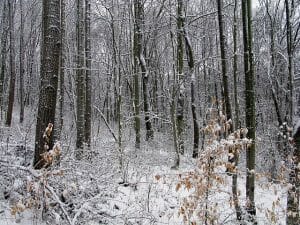About one-third of Earth is covered with forest. This represents two-thirds of the leaf area of all the land plants. The forests contain about 70% of the Earth’s carbon stores as well. Deciduous forests contain trees that lose their leaves once per year. In temperate deciduous forests, this happens in the fall and in tropical and subtropical deciduous forests, the leaves fall in the dry season.
Temperature
Temperate forests are found in eastern North America, Western Europe, Chile, New Zealand and Eastern Asia. Temperate deciduous forests need to have a growing season of 140-200 days within a 4-6 month period without frost. The average temperature of all deciduous forests in the world is around 50°F and annual temperatures ranging from -22°F to 86°F.
Tropical and subtropical deciduous forests only have 2 seasons, rainy and dry, with the leaves dropping in the dry season. These forests have a much narrower annual temperature range of 68°F to 77°F. They are located in and around the equatorial regions of the planet.

The image above shows a temperate deciduous forest during the winter season.
Precipitation
In temperate deciduous forests, the average annual precipitation ranges from 30” to 60” in the form of rain and snow and it is dispersed evenly throughout the year. Temperate deciduous rainforests have more than 60” of annual precipitation.
In tropical and subtropical deciduous forests, the annual rainfall is over 80” and it is also evenly distributed throughout the year. Although the sunlight and temperatures in these forests remain relatively constant, the amount of monthly rainfall can vary greatly. There can be 12” of rain during the wet months and as little as 4” in the dry months.
References
- OpenStax, Biology. OpenStax. May 20, 2013. http://cnx.org/content/col11448/latest/
- The Forest Biome. (n.d.). Retrieved October 7, 2017, from http://www.ucmp.berkeley.edu/glossary/gloss5/biome/forests.html
